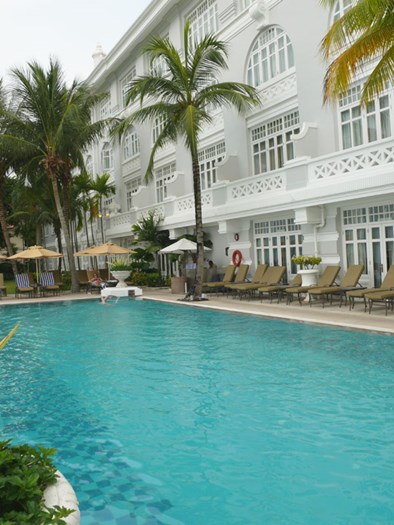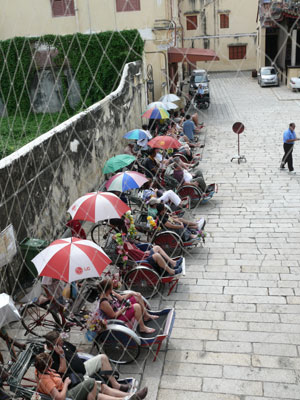GEORGE TOWN, MALAYSIA - The slender man standing behind the trishaw, this old colonial town’s version of the more famous rickshaw, invited my partner and I to let him show us the sights of this mini-Singapore.
The little man didn’t look strong enough to stand, let alone peddle two hulking North Americans around the narrow streets that make up this historic city in Penang, one of the smallest states in Malaysia.
Just like the much bigger and far more famous Singapore, an hour’s flight away to the south, George Town is where people of Malaysian, Indian and Chinese heritage live together in harmony.
And just like Singapore, George Town offers colorful districts that reflect the diverse makeup of its population – Little India, Chinatown and a vibrant area where Muslims, who make up the bulk of Malaysia’s population, work, worship and relax in neighborhood restaurants, high-octane discos and the magnificent beaches that ring the island state.
“Please, enjoy a one hour tour with me. I will show you all the highlights of George Town,” said the Malaysian man whose trishaw was decked out in plastic flowers.
After negotiating a price of 60 riggits (the local currency) – about $20 – we squeezed into the trishaw’s bucket seat and headed out on our tour of this lush island sold to the British in 1786 by a local sultan in return for protection.
Captain Francis Light, who acquired Penang Island on behalf of the East India Company, renamed it Prince of Wales Island and named its capital George Town after the English prince who later became King George IV.
Penang is accessible from the mainland by ferry or the recently constructed Penang Bridge, which, at 13.5 kilometres in length, is Asia’s longest. A local man later told us that the bridge was built to accommodate 70,000 cars a day and on a local holiday it easily reaches that number.
Half of Penang Island is best known for its beautiful scenery, fruit plantations, waterfalls and Malay villages featuring traditional houses surrounded by lovely gardens. A large mountain range cuts through the spine of the island and from the ferry George Town’s harbour, with its mountain backdrop and multitude of high-rise apartments, looks like a mini-Hong Kong.
George Town is now an exclusive resort community known for its pristine beaches, holiday hotels and a place where rich Malaysians from Kuala Lumpur park their million-dollar yachts in the modern marina. But the historic aspect of George Town has been well preserved and remains the main draw for foreign visitors to Malaysia.


Left: Swank colonial-era hotels are in much demand. Right: Tourists are taken around city on trishaws.
Now that we were securely in place, the little man began pushing the trishaw to get up a head of steam and then jumped onto his seat and began peddling. Thankfully for him, most of George Town is flat.
“We stop first at Cannon Square to see Khoo Kongshi,” said the man of the city’s most famous landmark, a 19th-century Chinese clan house whose elaborate decorations, including gold inlay ornaments, frescoed walls, encrusted roof, massive carved columns and ancient inscriptions, is one of the finest examples of its kind anywhere in Asia.
Cannon Square is also where our trishaw driver pointed out the beautiful Acheen Street Mosque, a Malay worshipping place built in 1808 and whose octagonal minaret is one of the city’s architectural highlights. Also in the square is the Yap Kongshi Temple, where the ancestral tablets of the Yap clan can be found.
The trishaw tour passed the Cheong Fatt Tze Mansion, another fine example of Chinese architecture; the upper class Muslim residence known as Segara Ninda; the Christian Cemetery where many of the early European occupiers of Penang, including Captain Francis Light, are buried; the State Museum, which is housed in what was the original Penang Free School; the Supreme Court Building, which was first built in 1808; the Goddess of Mercy Temple, built by Chinese settlers in the early 1800s, St. George Church, a stately landmark and the earliest Anglican Church in the region; the ochre-domed Kapitan Keling Mosque, another leftover from the 1800s – all this and we hadn’t even hit Little India yet.
“We soon be at Little India,” said the driver who shortly after turned onto Lebuh Chulia (lebuh means street), one of the roads that make up the area known as Little India and which features shops selling spices, silk sarees and many other Indian treasures.
Little India, which stretches from Lebuh Chulia to Lebuh China and includes Lebuh Queen, Lebuh Pasar, Lebuh King and Lebuh Penang, was first established in the time of Captain Light, who invited Indian merchants to set up shop here.
The streets of Little India are highlighted by brightly decorated shops selling the previously mentioned spices and sarees as well as metalware, hand-strung flower garlands, jewellery and lots and lots of Indian food.
The streets of Little India were abuzz with traffic and pedestrians as we passed and shopkeepers stood at their entrances hoping for business. We asked the driver if we could stop but he told us that would eat into too much of our one-hour tour and suggested we return later.
The area is littered with old temples, the most impressive of which is the Mahamariamman Temple, the oldest in Penang and whose roof is decorated with elaborate carvings and painted in bright colours.
The driver navigated the narrow streets on George Town masterfully but the traffic around the centre of town was becoming more congested and the rickety trishaw was no match for the oncoming cars and trucks.
“No worry,” said the driver as we expressed a concern for our safety, “we are kings of the road.”
The humble trishaws and their precious cargo of foreign visitors do indeed rule the roads of George Town and when the rider sticks out his hand to signal a merge into oncoming traffic, the cars and trucks give way – thankfully.
The back end of our tour included some more interesting sightings of area icons, like:
· Dr. Sun Yat Sen’s Penang base, where the noted revolutionary and the national father of modern China – he overthrew the Qing Dynasty - planned the historic 1911 Canton uprising from a home at 120 Lebuh Armenian from 1909 to 1911;
· The Syed Alatas Manion, a recently restored bungalow and an early example of an early Straits-Eclectic Muslim building;
· The Victoria Memorial clock tower, erected to celebrate Queen Victoria’s Diamond Jubilee in 1897;
· Fort Cornwallis, originally a wooden stockade established when Captain Light landed in 1786 and later reconstructed into its present stone state;
· The original town hall, built in 1880 and, along with the equally imposing City Hall building built in 1903, are two of the most impressive structures along the city’s seafront;
· The 65-story Komtar building, which houses government offices, a department store, restaurants, shops and a geodesic dome which features exhibition.
Before reaching our intended destination, the charming and historic Eastern and Orient Express hotel at the water’s edge, the driver pointed to a handsome colonial building on Downing Street and said: “That our No.10 Downing Street,” referring to its more famous London equivalent, which is home to British prime ministers. Here, No. 10 Downing Street is just a restored building used now for commercial purposes.
The E&O Hotel, as it is known locally, is a replica of Singapore’s landmark Raffles Hotel and was built by the Armenian Sarkie brothers, the same family who built the legendary Raffles.
The hotel once boasted having the longest seafront of any hotel on Penang and still retains much of its colonial charm, including antique wooden ceiling fans, rich dark wood floors and walls, and its original 1903 ballroom.
The driver suggested we enjoy a drink under the swaying palm trees that dot the E&O’s manicured property before heading back to the ferry.
The steel-legged driver bowed his perspiring head, thanked us for the 60 riggits (plus a small bonus for his effort and expert guidance), smiled, jumped back on his trishaw and headed off in search of another fare.
In just one short hour, we had enjoyed the ride of our life discovering why George Town makes a visit to Malaysia well worth the trip.